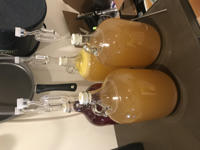
Stuff you need:
- Glass jug (half gallon, gallon, or 5 gallon)
- stopper and airlock for the jug
- IOStar iodine sanitizer (or other similar brew sanitizer)
- Cleaning brush
- yeast
- honey
- water
What to do:
- Clean everything
The single most important thing in brewing is making sure everything is properly sanitized. Pour half a spoonful or so of the sanitizer into your jub, add a good bit of hot water, and scrub it with the brush. Get a bowl, and pour some of the mix into the bowl, and use that to sanitize your stopper and airlock.
- Add honey
Pour your honey into the jug. Don't heat it. I usually buy squeeze bottles, so I squeeze out most of the honey, then add cold water, shake vigorously, and squeeze out again. Repeat a couple times until you've rinsed out all the honey.
How much honey depends on how sweet you want the mead. I usually about 3-5 pounds (48-64 oz by weight) per gallon, or about 20-25 pounds for a 5 gallon batch, but this makes for very sweet mead. Experiments underway on making some that's less sweet.
What kind of honey also influences the taste. I've experimented with clove honey, wildflower honey, and New Mexico mesquite honey, and all were great.
- Add water
Fill the rest of the jug, but not quite to the top. Leave room for about 2 cups of water we're going to add in a minute.
- Add yeast
I've used two different yeasts:
My first batches were made using WLP002, an ale yeast. I found the flavor very pleasant, but the fermentation stops when the alcohol by volume (ABV) hits about 4-5% (basically the same ABV as a typical ale). The WLP002 comes in liquid/goo form in a tube. You have to keep it refridgerated.
If you want something a little stronger, use Lalvin ICV-D47 wine yeast. This can go up to about 14% ABV.
There are two ways to add the yeast.
First, you can do it the fancy way. Sanitize a glass, add about 2 cups of water, and microwave until it's about 90 degrees F (or whatever the temperature on the yeast container instructs - I usually use a laser thermometer to verify temperature). Add the yeast to that cup and let it sit for about 15 min. Then pour this mix into the jug.
The lazy way is just to dump the yeast straight into the jug and top off with water.
Optionally, you can add some yeast nutrient to get the yeast started. I use about two spoonfuls of Fermaid O for a gallon. This is especially helpful for the beer yeast, which is not made to process honey and may need a little help getting started.
Either way, give the jug a little swirl, or a stir or two with a spoon you've sanitized.
Add the stopper, put water in the airlock.
- Wait
At first, it may seem like nothing is happening. Have patience.
After anywhere from a few hours to a few days, you should see little bubbles rising and perhaps a foam at the top.
After 2-4 weeks, the bubbling will slow and eventually stop.
Wait a week or two after all activity stops.
- What next?
You can just change out the stopper/airlock and put the jug in the fridge to drink.
If you don't like yeast in your mead, you can either carefully pour or siphon off mead into the bottles (that you sanitized of course), using a coffee filter if you want.
Keeping the mead refridgerated and sealed helps ensure that no more fermentation happens (if much fermentation happens in a sealed container, it tends to explode from CO2 buildup).
If you want even higher ABV, sanitize a plastic bottle, pour in the mead, and freeze it for a day or two. Take the bottle out, and flip it upside down so the liquid that hasn't frozen can pour out. Let it drain until what's dripping out is clear and the ice remaining is mostly clear. Repeat 2-3 times. This is known as freezer jacking and the product sometimes called honey jack.
- Spices and Fruits
If into that kind of thing, you can add some spice or fruit after adding the honey. For fruit, blend it as finely as possible. Cinnamon or other holiday-ish spices are good. I've done batches with blueberry, strawberry, and orange, all of which were tasty, but frankly I prefer the plain product.
